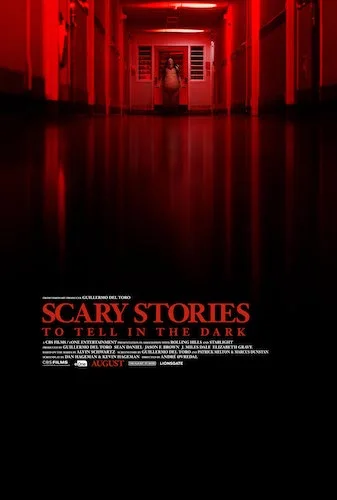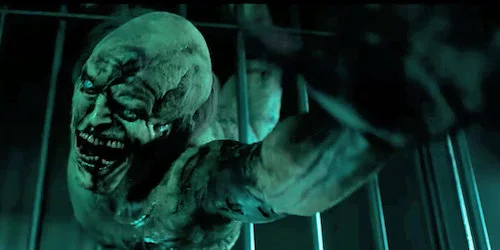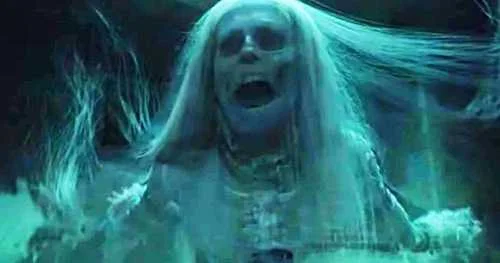Scary Stories to Tell in the Dark
I mean, the title of the film and its source novel is clearly Scary Stories to Tell in the Dark, but ten minutes into the minute made me think I was watching Stupid Stunts for Teenagers to Attempt instead. The original Alvin Schwartz stories (along with the authentically nauseating illustrations by Stephen Gammell) created a chilling atmosphere where your mind did most of the work. The words were disturbing and often revolting, but you needed to use them as stepping stones to get to your next destination. The illustrations were images frozen in time, yet every wisp of hair, cracked wrinkle and ghastly grin instilled life in the unimaginable. When Guillermo del Toro helped adapt the story to the screen, he agreed to allow the film to represent one sprawling story instead of a collection of many, as to not allow any weak parts or unmatched expectations. The notion was good, but the end result is still barren of life. Within minutes, I felt a large disconnect between me and the feature.
Maybe having a collection of stories allowed each horrific creature to have their own stage. In this film, you can tell that André Øvredal tries to get every frightening moment to not necessarily be a jump scare, but that’s what they all resort to. Something messed up will happen, then we cut away to something else. To make these sequences attach to the whole narrative, they are plopped into the recipe with a pinch of buildup for the tastes to infuse together. Either way, these are jump scares. No ifs, ands or buts. If there is one point I have to make abundantly clear every time I review a horror film like this (and there will be many), it’s that having a bunch of jump scares does NOT create suspense. It just creates predictability. Maybe we’ve forgotten what we learned in pre school or kindergarten, but tell me if this is familiar.
∆O∆O∆O?
What’s the next shape in the sequence:
a) ∆
b) O
c) •
d) the next step in the DaVinci Code
If your answer is a) ∆, then, congratulations. You recognize patterns. So does your brain. It is familiar with musical cues, shifts in editing, and all of the other elements that set up a jump scar. Familiarity removes surprise, like the same joke being told a thousand times. Say the same joke with different words, but having the same punch line won’t make any of the efforts matter. Why did Psycho and that scene freak everyone out? No one expected it, especially with a leading star. Mulholland Drive and even Pee-Wee’s Big Adventure have truly frightening jump scares, because you would never assume these films would have them. The Exorcist had jump scares, sure, but it also had a story that didn’t rely on them, and it created an actual environment where the paranormal exists even outside of them. That’s the key. If you mostly see ghouls and monsters when they leap at you and rarely elsewhere, why do we care when we can expect them during these split seconds and escape them right after? Nothing is scarier than facing these images and sounds during scenes where we are comfortable.
Oh, wait, come back. There’s nothing to fear here. This is just my neighbour Steve wanting to borrow some sugar.
One thing Dark does that helps its existence is turning the book (not the actual book, but a book that tells stories similarly) into a key plot device here. The book starts to “write” itself, dictating fate and what is going to happen next. Like a demented Stranger than Fiction, this tames jump scares and turns them into fortunes being told. It’s a saving grace that kicks in some distance into the film, and renders the remainder at least tolerable and not a mindless chore. You follow the lead characters as they try to stop the predictions from coming true. It’s interesting, because all of this was provoked by these teenagers engaging in dumb activities in the first place. The characters are pessimistic and largely unlikeable in the calmer moments, but it’s during their times of need that everyone bands together and they experience a maturation to get them through this torture. This film could also be retitled Comeuppance: The Quickest Way to Learn, but I guess its actual title will do.
One thing that softens the proper blows the film should expose (the ways these characters grow and how each part changes them) is how quickly the film moves on. Hell, it wanted to get right into the good stuff immediately, as the film dives into its Halloween theme within seconds. However, we want to care about these characters, even after they were rotten little cretins from the get go, but the film says “Nah. Let’s just spook you some more”. Again, there are neat ideas here (I haven’t even gotten into some of the actual scares, but I’ll let the film do that for you, since it’s the film’s sole priority, clearly), but nothing really ever clicks underneath the weight of the pressure to scare. It’s like watching a superstar athlete choke in the Olympics. You know it’s supposed to do what it does best, but it never rises to the occasion despite its best efforts. Also, there’s something especially irritating about having the remaining lead characters always show up a few seconds too late when something bad happens. May as well call this film Slow Characters that are Always Tardy.
Oh, hang on, I gotta deal with this. Yes, here’s your screener copy of Dora and the Lost City of Gold. Let me know what you think, Ashley! Say hi to Ashley, everyone. She’s an aspiring critic. Okay, back to business.
Look. What we have here is clearly a bunch of filmmakers that loved these stories growing up, and they wanted to bring this experience to a new generation. Scary Stories to Tell in the Dark just doesn’t work out all that well. It’s far from the laziest horror film, but that doesn’t make it a good one either. We’re actually being told one story with various outcomes. None of them are scary. I’m barely going to talk about this film ever again, let alone vow to tell it in full. The only darkness I partake in is when I sleep, and when I see a film in a cinema. This wasn’t the book you read to your children if you were a daring parents, or the one you read if you were an even more daring youth. Like the Tenacious D song, this is just a tribute. I guess the most fitting title, if I have to try this one last time is, “Eh: From Start to Finish”. It’s a near two hour shrug with the occasional hiccup mistaken for a leap of fright. It’s hardly offensive to watch, but that’s almost the biggest flaw here. You can tell it was meant to be. Eh.
Andreas Babiolakis has a Masters degree in Film and Photography Preservation and Collections management from Ryerson University, as well as a Bachelors degree in Cinema Studies from York University. His favourite times of year are the Criterion Collection flash sales and the annual Toronto International Film Festival.






